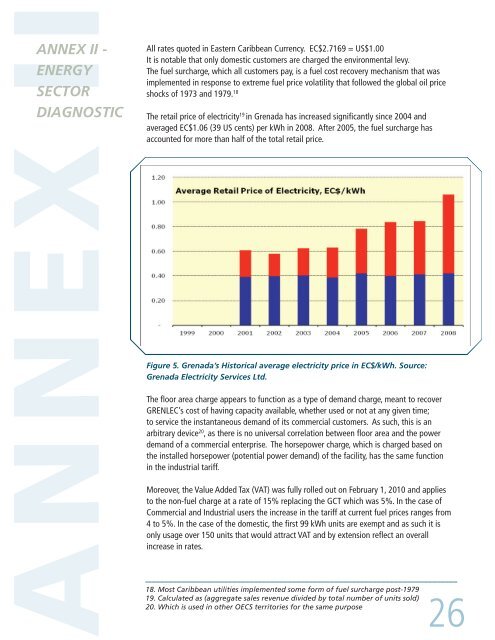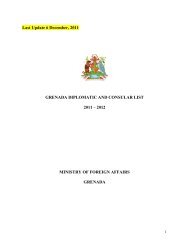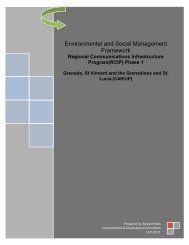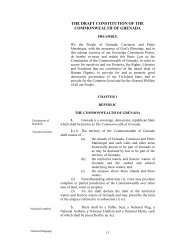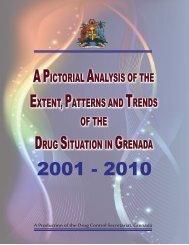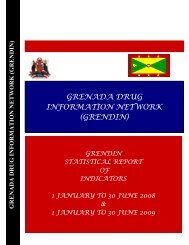THE NATIONAL ENERGY POLICY OF GRENADA - Government of ...
THE NATIONAL ENERGY POLICY OF GRENADA - Government of ...
THE NATIONAL ENERGY POLICY OF GRENADA - Government of ...
You also want an ePaper? Increase the reach of your titles
YUMPU automatically turns print PDFs into web optimized ePapers that Google loves.
ANNEX II<br />
ANNEX II -<br />
<strong>ENERGY</strong><br />
SECTOR<br />
DIAGNOSTIC<br />
All rates quoted in Eastern Caribbean Currency. EC$2.7169 = US$1.00<br />
It is notable that only domestic customers are charged the environmental levy.<br />
The fuel surcharge, which all customers pay, is a fuel cost recovery mechanism that was<br />
implemented in response to extreme fuel price volatility that followed the global oil price<br />
shocks <strong>of</strong> 1973 and 1979. 18<br />
The retail price <strong>of</strong> electricity 19 in Grenada has increased significantly since 2004 and<br />
averaged EC$1.06 (39 US cents) per kWh in 2008. After 2005, the fuel surcharge has<br />
accounted for more than half <strong>of</strong> the total retail price.<br />
Figure 5. Grenada’s Historical average electricity price in EC$/kWh. Source:<br />
Grenada Electricity Services Ltd.<br />
The floor area charge appears to function as a type <strong>of</strong> demand charge, meant to recover<br />
GRENLEC’s cost <strong>of</strong> having capacity available, whether used or not at any given time;<br />
to service the instantaneous demand <strong>of</strong> its commercial customers. As such, this is an<br />
arbitrary device 20 , as there is no universal correlation between floor area and the power<br />
demand <strong>of</strong> a commercial enterprise. The horsepower charge, which is charged based on<br />
the installed horsepower (potential power demand) <strong>of</strong> the facility, has the same function<br />
in the industrial tariff.<br />
Moreover, the Value Added Tax (VAT) was fully rolled out on February 1, 2010 and applies<br />
to the non-fuel charge at a rate <strong>of</strong> 15% replacing the GCT which was 5%. In the case <strong>of</strong><br />
Commercial and Industrial users the increase in the tariff at current fuel prices ranges from<br />
4 to 5%. In the case <strong>of</strong> the domestic, the first 99 kWh units are exempt and as such it is<br />
only usage over 150 units that would attract VAT and by extension reflect an overall<br />
increase in rates.<br />
18. Most Caribbean utilities implemented some form <strong>of</strong> fuel surcharge post-1979<br />
19. Calculated as (aggregate sales revenue divided by total number <strong>of</strong> units sold)<br />
20. Which is used in other OECS territories for the same purpose<br />
26


